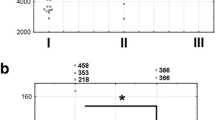Abstract
Cerebrospinal fluid lymphocyte subsets in patients with tickborne encephalitis (TBE) and in patients with TBE with concomitant neuroborreliosis (double infection) were analysed by flow cytometry. In the TBE group, higher percentages of CD4+DR+ T cells (p = 0.02) and CD25+ T cells (p = 0.0002) were observed, while in the group with double infection, higher percentages of CD19+ cells (p = 0.007), CD8+DR- T cells (p = 0.04), and CD3+CD71 + T cells (p = 0.0002) were found. It was concluded that several differences in immune cell parameters are present between the two groups of patients. Three variables (CD19+ cells, CD3+CD25+ T cells, CD3+CD71 + T cells) were included in the logistic regression model for calculation of probability for double infection. Flow cytometric characterisation of lymphocyte subsets in CSF can further substantiate the diagnosis of concomitant neuroborreliosis in patients with TBE.
Similar content being viewed by others
References
Wahlberg P, Saikku P, Brummer-Korvenkontio M: Tickborne viral encephalitis in Finland. The clinical features of Kumlinge disease during 1959–1987. Journal of Internal Medicine 1989, 225: 173–177.
Steere AC: Lyme disease. New England Journal of Medicine 1989, 321: 586–596.
Luft BJ; Steinman CR, Niemark HC, Muralidhar B, Rush T, Finkel MF Kunkel M, Dattwyler RJ: Invasion of the central nervous system byBorrelia burgdorferi in acute disseminated infection. Journal of the American Medical Association 1992, 267: 1364–1367.
Pachner AR, Steere AC: The triad of neurologic manifestations of Lyme disease: meningitis, cranial neuritis, and radiculoneuritis. Neurology 1985, 35: 47–53.
Wilske B, Schierz G, Preac Mursic V, von Bush K, Kühbeck R, Pfister HW, Einhäupl K: Intrathecal production of specific antibodies againstBorrelia burgdorferi in patients with lymphocytic meningoradiculitis (Bannwarth's syndrome). Journal of Infectious Diseases 1986; 153: 304–314.
Strle F, Cheng Y, Nelson JA, Picken MM, Bouseman JK, Picken RN: Infection rate ofIxodes ricinus ticks withBorrelia afzelii, Borrelia garinii, andBorrelia burgdorferi sensu stricto in Slovenia. European Journal of Clinical Microbiology & Infectious Diseases 1995, 14: 994–1001.
Kristoferitsch W, Stanek G, Kunz C: Doppelinfektion mit Frühsommermeningoenzephalitis — (FSME) virus undB. burgdorferi. Deutsche Medizinische Wochenschrift 1986, 111: 861–864.
Matsui M, Mori KJ, Saida T: Cellular immunoregulatory mechanisms in the central nervous system: characterisation of noninflammatory and inflammatory cerebrospinal fluid lymphocytes. Annals of Neurology 1990, 27: 647–651.
Hosmer DW, Lemeshow S: Applied logistic regression. Wiley & Sons, New York, 1989.
Gustafson R, Forsgren M, Gardulf A, Granström M, Svenungsson B: Clinical manifestations and antibody prevalence of Lyme borreliosis and tick-borne encephalitis in Sweden: study in five endemic areas close to Stockholm. Scandinavian Journal of Infectious Diseases 1993, 25: 595–603.
Kuiper H, de Jongh BM, van Dam AP, Dodge DE, Ramselaar ACP, Spanjaard L, Dankert J: Evaluation of central nervous involvement in Lyme borreliosis patients with a solitary erythema migrans lesion. European Journal of Clinical Microbiology & Infectious Diseases 1994, 13: 379–387.
Zbinden R, Goldenberger D, Lucchini GM, Altwegg M: Comparison of two methods for detecting intrathecal synthesis ofBorrelia burgdorferi-specific antibodies and PCR for diagnosis of Lyme neuroborreliosis. Journal of Clinical Microbiology 1994, 32: 1795–1798.
Merelli E, Sola P, Faglioni P, Giordani S, Mussini D, Montagnani G: Natural killer cells and lymphocyte subsets in active MS and acute inflammation of the CNS. Acta Neurologica Scandinavica 1991, 84: 127–131.
Schädlich HJ, Felgenhauer K: Diagnostic significance of IgG-synthesizing activated B cells in acute inflammatory diseases of the central nervous system. Klinische Wochenschrift 1985, 63: 505–510.
Beuche W, Siever A, Felgenhauer K: Specific antigen binding by activated cerebrospinal fluid B lymphocytes in acute neuroborreliosis. Journal of Neurology 1992, 239: 322–326.
Thomas RS, Beuche W, Felgenhauer K: The proliferation rate of T and B lymphocytes in cerebrospinal fluid. Journal of Immunology 1991, 238: 27–30.
Chiao JW, Pavia C, Riley M, Altman-Lasekan W, Abolhassani M, Liegner K, Mittelman A: Antigens of Lyme disease of spirocheteBorrelia burgdorferi inhibits antigen or mitogen-induced lymphocyte proliferation. FEMS Immunology and Medical Microbiology 1994, 8: 151–156.
Author information
Authors and Affiliations
Rights and permissions
About this article
Cite this article
Tomažič, J., Ihan, A., Strle, F. et al. Immunological differentiation between tickborne encephalitis with and without concomitant neuroborreliosis. Eur. J. Clin. Microbiol. Infect. Dis. 16, 920–923 (1997). https://doi.org/10.1007/BF01700560
Issue Date:
DOI: https://doi.org/10.1007/BF01700560




